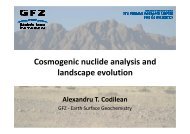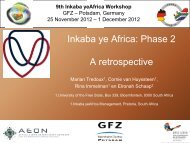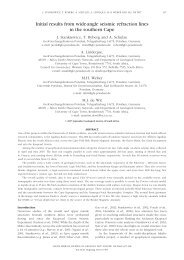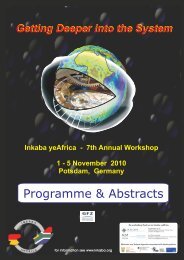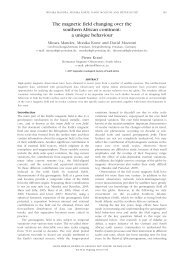South Africa - Inkaba.org
South Africa - Inkaba.org
South Africa - Inkaba.org
Create successful ePaper yourself
Turn your PDF publications into a flip-book with our unique Google optimized e-Paper software.
Paleonenvironmental reconstruction of the Tanqua Basin, SW<br />
Karoo, <strong>South</strong><br />
M Patel 1 & D Mikeš 2<br />
1. Stellenbosch University, <strong>South</strong> <strong>Africa</strong>, malikahpatel@gmail.com<br />
2. Stellenbosch University, <strong>South</strong> <strong>Africa</strong>, mikes@sun.ac.za<br />
ABSTRACT<br />
Deltaic build-out into the south-western Karoo Basin represents the last major phase of Ecca deposition. This study<br />
focuses on the Ecca Group of the Tanqua depocentre which consists of a progradational siliciclastic succession<br />
from submarine fan, prodelta, delta front to delta plain systems. The deltaic system has only been studied by few<br />
and then only regionally. This study therefore focuses on the nature of the deltaic depositional environment and its<br />
evolution through time. A detailed facies analysis is conducted to build a suitable facies model for the Tanqua<br />
depocentre, which will then be used as a comparative study with existing facies models.<br />
The Kookfontein formation is comprised of 13 cycles, dominant processes operating on the Tanqua submarine<br />
slope vary temporally and spatially, which directly influences the distribution of facies and architecture. Cycles 1-<br />
3 have been studied in detail. Cycle 1 is dominantly composed of thin-bedded, very fine grained- graded sandstone<br />
and siltstone (heterolithic sst) interbedded with fine siltstones and mudstone facies consisting of four thickening<br />
and coarsening-upwards units which is capped by a thinning and fining-upward unit. Cycle 2 attains an average<br />
thickness of 30m, exhibiting a profile which generally coarsens and thickens upwards whilst the top most layers<br />
have a thin, fining- upwards sequence. Cycle 3 exhibits a more symmetrical profile with units of mudstone (siltyclaystone)<br />
and heterolithic very fine grained sandstone.<br />
These cycles which characterise the proximal pro-delta/distal delta front deposits often contain distal distributary<br />
mouth bar deposits as well as slumped units. Large-scale failure events and slumps observed within cycles 2 and 3,<br />
typically occur in a lower to base of slope setting, but which has been demonstrated within the study area to occur<br />
on the mid to upper slope.<br />
KEYWORDS: Facies analysis; deltaic succession; Tanqua Depocentre; southwest Karo<br />
69



